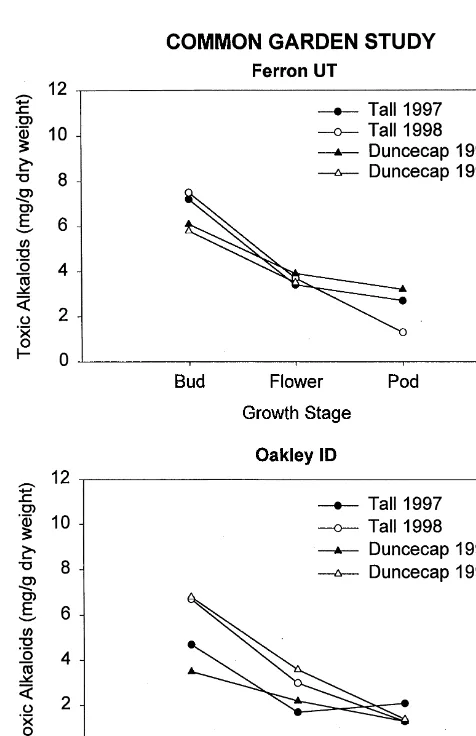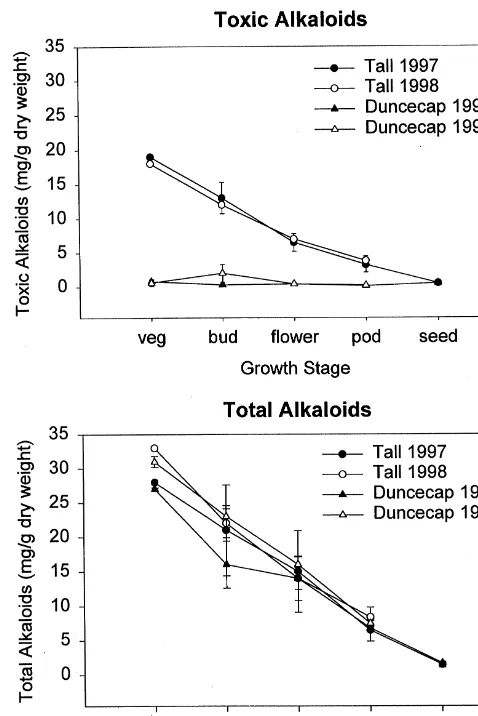Alkaloid levels in Duncecap (
Delphinium
occidentale
) and Tall larkspur (
D. barbeyi
)
grown in reciprocal gardens: separating genetic
from environmental in
#
uences
Michael H. Ralphs
*
, Dale R. Gardner
USDA/ARS Poisonous Plant Research Lab, 1150 E. 1400 N., Logan Utah 84341, USA
Received 16 September 1999; accepted 28 March 2000
Abstract
The objective of this study was to determine whether di!erences in toxicity between Tall
larkspur (Delphinium barbeyi) and Duncecap larkspur (D. occidentale) were genetically inherent
within the species, or due to environmental in#uences unique to the di!erent regions where they grow. There was no di!erence in the concentration of the toxic alkaloids between the two species when grown in common gardens. However, both species had higher concentration of toxic alkaloids when grown in the southern Rocky Mountain region which is characterized by summer monsoonal thunderstorms, compared to summer drought in the north. In a unique occurrence where Duncecap larkspur grew beside Tall larkspur, toxic alkaloids were very low in Duncecap larkspur, but total alkaloid concentration was often higher than in Tall lark-spur. Published by Elsevier Science Ltd.
Keywords: Duncecap larkspur;Delphinium occidentale; Tall larkspur;Delphinium barbeyi; Norditerpenoid alkaloids; Toxic alkaloids; Environmental stress
1. Introduction
Two species of mountain larkspurs are responsible for most of the cattle poisoning and subsequent deaths on the western U.S. mountain rangelands. Duncecap larkspur (Delphinium occidentale) occurs in the mountain ranges throughout the Great Basin and Intermountain region in Nevada, Idaho and northern Utah, and in
*Corresponding author. Tel.:#1-435-752-2941; fax:#1-435-753-5681. E-mail address:[email protected] (M.H. Ralphs).
the northern Rocky Mountains of Wyoming and Montana. It has smaller, light blue
#owers with a straight spur, and a purplish, waxy or glabrous stem. It generally grows in clumps of 3}10 stalks/plant. Tall larkspur (D. barbeyi) occurs in the southern Rocky Mountains of southern Utah and Colorado. It has larger deep purple#owers with more of a curved spur, and dense glandular yellow hairs on the stem, particularly in the upper in#orescence. It is a large robust plant having 20}50 stalks/plant.
Early research suggested that Tall larkspur is more toxic than Duncecap (Beath 1925; D. cuculatum referred to by Beath is now considered D. occidentale). Olsen (1977) reported Tall larkspur was 10 times more toxic than Duncecap as determined by rat bioassay of alkaloid extracts. The toxins in larkspur are norditerpenoid alkaloids, and structure-activity relationships have shown theN-(methylsuccinimido) anthranoyllycoctonine (MSAL) class of alkaloids to be more toxic than those alkal-oids which do not contain this functional group (Manners et al., 1995). Since all the MSAL alkaloids are similar in toxicity, we have grouped them together for analyses. Gardner et al. (1997) developed a method using Fourier-transformed infrared spectro-scopy (FT-IR) that can selectively measure the MSAL alkaloids, allowing a conve-nient quantitative separation of the most toxic alkaloids from the total alkaloids in larkspur species.
The principal MSAL alkaloid, methyllycaconitine (MLA), produced signs and severity of toxicosis consistent with feeding whole larkspur plants to cattle (Nation et al., 1982; Kip Panter unpublished data). The toxicity of larkspur to cattle has been related to the concentration of the MSAL alkaloid fraction in the mountain larkspur species (P"ster et al., 1994).
Ralphs et al. (1997) reported that the MSAL alkaloid concentration was much higher in Tall larkspur in early growth stages than in Duncecap. However, it is not clear whether these di!erences are inherent within the species, or if they are caused by the di!erent environmental factors and climate of the regions where they occur. The
"rst objective of this study was to compare the MSAL alkaloid content of these two species grown in reciprocal gardens, to separate the environmental e!ects of the di!erent regions from inherent genetic di!erences. The second objective was to compare MSAL and total alkaloid concentration of the two species in unique situations where they grow naturally together at the same location. If there are di!erences in toxicity between the species, then di!erent management strategies may be required to reduce the risk of poisoning.
2. Methods
2.1. Reciprocal garden study
where snowdrifts lie, and beneath aspen in the understory. Soil at the site was silty loam (Argic Cryoboralls). Total precipitation averaged 64 cm with 85% falling as winter snow. Only 9 cm falls as rain during the growing season. This region is characterized by winter snow, spring rains and summer drought. Soil moisture becomes limiting by mid-July and larkspur begins to senesce by August.
The Tall larkspur site was 46 km west of Ferron, Utah at 3150 m elevation. It is in the subalpine zone with scattered stands of subalpine"r interspersed within the tall forb community. Tall larkspur occurs in patches where snowdrifts lie. Soils were clayey skeletal montmorillic (Pachic Cryoborolls). Precipitation averaged 91 cm, with 75}80% as winter snow. The region is characterized by a bimodal precipitation pattern with heavy winter snow in the mountains and monsoonal summer thunderstorms. Over 18 cm of rain falls during the growing season in July and early August. Soil moisture is generally not limiting at this site and growth continues throughout the summer until frost in early September.
Common gardens were established at both locations in 1992. Forty plants of each species were dug up and transplanted at each location. The tap root was severed 30}40 cm below the soil surface, but all the adventitious roots from the caudex were intact. Species were planted in alternating rows with 10 plants/row on 1 m centers. The gardens were fenced to prevent grazing, and were hand grubbed to reduce competi-tion. Plants were watered 2}3 times for the "rst 2 summers to help establishment. However, survival was low. In 1997, only 4 plants of each species survived at Oakley and 8 plants of each species survived at Ferron. Those plants that survived were healthy and robust, having 5}10 healthy stalks.
One stalk of each of the surviving plants was harvested at the bud,#ower, and pod stage of growth in 1997 and 1998. The stalks were placed in plastic bags and immediately frozen on dry ice. They were freeze dried, ground in a Wiley mill to pass through 1 mm screen, then extracted and analyzed for MSAL and total alkaloid concentration using the method of Gardner et al. (1997).
MSAL and total alkaloid concentration were compared statistically by the mixed procedure in SAS, using compound symmetry covariance in a split plot design over time. Location and year were the main e!ects, plants within locations were the repeated factor, and growth stage was the split plot.
2.2. Species growing together
Table 1
Concentration of MSAL and total alkaloids (mg/g dry weight,$SE) in Tall and Duncecap larkspur grown in reciprocal gardens at Ferron UT. and Oakley ID!
Location Year Toxic MSAL alkaloids (mg/g) Total alkaloids (mg/g)
Tall Duncecap Mean Tall Duncecap Mean
!Column means for species and row means for years that are not followed by the same lower case letter di!er signi"cantly (p(0.05). Grand means for location or species that are not followed by the same capital letter di!er signi"cantly (p(0.05).
The Yampa site was 20 km west of Yampa, Colorado at 2600 m elevation. Dun-cecap larkspur occurred in open areas in the mountain big sagebrush#ats, while Tall larkspur was very dense under aspen canopy in the tall forb plant community. Composite samples were taken from several plants of each species in 1996 and 1997. MSAL and total alkaloids were analyzed by FT-IR as described above.
3. Results and discussion
3.1. Reciprocal garden study
There was no di!erence in MSAL alkaloid concentration between the two larkspur species (P"0.88, Table 1). Total alkaloid concentration was 3 times greater than MSAL alkaloids, but there was no di!erence between species (P"0.20). We conclude, there is no inherent di!erence in toxic MSAL alkaloid concentration between Dun-cecap and Tall larkspur when grown in common environments.
Fig. 1. Toxic alkaloid concentration (mg/g dry weight) in Tall and Duncecap larkspur growing in reciprocal gardens at Ferron, UT and Oakley, ID.
seldom limiting, allowing the deep rooted larkspur to grow throughout the summer. The Ferron location was also at a higher elevation, thus had cooler temperatures. The Great Basin and Intermountain Region climate where Duncecap larkspur grows is characterized by summer drought. Duncecap larkspur completes its growth cycle early in the summer and begins to senesce by late July. Soil di!erences may also have had an impact, with the Ferron UT site having heavy clays, compared to silty loam soil at Oakley, ID. Ultraviolet irridation may also have been di!erent between the di!erent altitudes and latitudes.
Table 2
Concentration of MSAL and total alkaloids (mg/g dry weight,$SE) in Tall and Duncecap larkspur growing naturally together at Salina, UT and Yampa CO
Location Year Part MSAL alkaloids Total alkaloids
Tall Duncecap Tall Duncecap
Salina, UT 1994 Leaf 6.42 0.61 18.3 32.3
Head 3.58 n.d! 16.3 27.9
1996 Leaf 5.67 0.41 12.68 16.9
1997 (mean) Whole plant 6.8$2.0 0.4$0.1 12.3$3.2 13.1$3.0 1998 (mean) Whole plant 7.9$1.1 0.8$0.4 15.3$1.9 17.6$2.0
Yampa, CO 1996 Whole plant 4.56 0.11 9.5 11.4
1997 Leaf 2.47 n.d! 5.6 2.8
Head 2.62 n.d! 5.6 10.7
!None detected(0.1 mg/g.
alkaloid concentration were lower in 1997 at Oakley (Fig. 1). Spring precipitation was lower in 1997 than in 1998 at Oakley.
3.2. Species growing together
Natural populations of Duncecap larkspur growing among the Tall larkspur populations at both Salina, UT and Yampa, CO contained very little MSAL alkaloids (Table 2, Fig 2). The lack of toxic MSAL alkaloids in these Duncecap larkspur populations growing within the Tall larkspur region is in stark contrast to Duncecap plants grown in the reciprocal gardens in the previous study. On the other hand, total alkaloids in Duncecap larkspur were substantially higher in some years than Tall larkspur growing beside it (Table 2).
These Duncecap larkspur plants growing within the Tall larkspur region may have hybridized with Tall larkspur, maintaining the morphological characteristics of Dun-cecap, but suppressing the genes for MSAL synthesis. The Salina population of Duncecap appears to be a hybrid with genetic characteristics of both Duncecap and Tall larkspur, but the Yampa population has genetic characteristics principally of Duncecap (XiaMei Li, unpublished data). There is a growing amount of literature that suggests chemical defenses are lower in hybrids than their parents (Whitham et al., 1999).
4. Conclusion
Fig. 2. Toxic and total alkaloid concentration (mg/g dry weight) over the growing season in Tall and Duncecap larkspur growing together at Salina, UT.
precipitation pattern and resulting growth of Tall larkspur throughout the growing season is responsible for its' higher toxic alkaloid concentration, compared to Duncecap larkspur.
References
Beath, O.A., 1925. Chemical examination of three Delphiniums. Univ. Wyo. Agr. Exp. Sta. Bull. 143. Gardner, D.R., Manners, G.D., Ralphs, M.H., P"ster, J.A., 1997. Quantitative analysis of norditerpenoid
Manners, G.D., Panter, K.E., Peletier, S.W., 1995. Structure-activity relationships of norditerpenoid alkaloids occurring in toxic larkspur (Delphinium) species. J. Nat. Prod. 58, 863}869.
Nation, P.N., Benn, M.H., Roth, S.H., Wilkens, J.L., 1982. Clinical signs and studies of the site of action of puri"ed larkspur alkaloid, methyllycaconitine, administered parenterally to calves. Can. Vet. J. 23, 264}266.
Olsen, J.D., 1977. Toxicity of extract from three larkspur species (Delphinium barbeyi, D. glaucescens,andD. occidentale) measured by rat bioassay. J. Range Manage. 30, 237}238.
P"ster, J.A., Panter, K.E., Manners, G.D., 1994. E!ective dose in cattle of toxic alkaloids from tall larkspur (Delphinium barbeyi). Vet. Human. Toxicol. 36, 10}11.
Ralphs, M.H., Manners, G.D., P"ster, J.A., Gardner, D.R., James, L.F., 1997. Toxic alkaloid concentration in tall larkspur species in the western U.S. J. Range Manage. 50, 497}502.



